The Golden State Going Greener
Air Date: Week of June 11, 2021
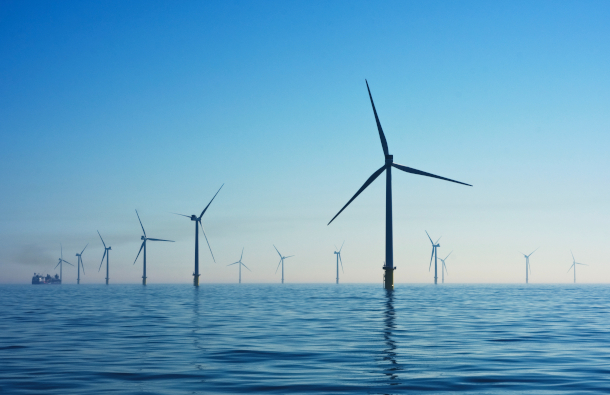
Turbines in the Rampion Offshore Wind Farm in the United Kingdom. In May 2021 the Biden administration and California Governor Gavin Newsom announced plans to open up the West Coast to offshore wind development for the first time. (Photo: Nicholas Doherty on Unsplash)
California has often led the nation in environmental ambition, and now that his state finds itself with a big budget surplus Governor Gavin Newsom wants to invest $14 billion of it in climate initiatives. That would help make progress on the state’s ambitious goal of net zero carbon emissions by 2045. Jared Blumenfeld is the secretary of the California Environmental Protection Agency and host of the podcast, Podship Earth, and he joins Living on Earth Host Steve Curwood to discuss offshore wind, environmental justice and more.
Transcript
CURWOOD: From PRX and the Jennifer and Ted Stanley Studios at the University of Massachusetts Boston, this is Living on Earth. I’m Steve Curwood.
California has often led the nation in environmental ambition, and just recently Governor Gavin Newsom set a goal of phasing out Golden state oil and gas extraction by 2045. That would help California reach its goal of net zero carbon emissions, also by 2045 and it’s already heading there. Per capita carbon emissions have fallen nearly 30% in the last two decades, and right now the Golden State suddenly has plenty of gold or rather cash thanks to a huge budget surplus. And the Governor wants to invest some of it in a greener future. Jared Blumenfeld is the secretary of the California Environmental Protection Agency, and hosts the podcast, Podship Earth. He’s on the line now from Sacramento. Welcome back to Living on Earth, Jared!
BLUMENFELD: Hey, Steve, it's great to be with you. I always enjoy getting to talk with you.
CURWOOD: It's a mutual pleasure. So California has some $75 billion right now in budget surplus. How is Governor Newsom planning to direct some of that money towards climate solutions? What's at the top of the list?
BLUMENFELD: Top of our list, Steve, is climate change, climate resiliency. We're looking at everything from putting money into helping recycled water and drinking water, all the way through, really doubling down our commitment to achieve zero emission fleets within our vehicles. The governor set a goal of getting all new car sales to be zero emission vehicles by 2035. But we also put a lot of emphasis on helping with trucks and cleaning those up as well, all the way through things about how we make agriculture more climate friendly, and how we sequester carbon into the soil, to things like how we work with schools to increase broadband, which can also help with reducing commute trips and things like that. So we put about $14 billion into the climate budget. And importantly, you know, we had three frames that we looked at this really historic opportunity: equity, measurable health benefits, and reduction in pollutants -- climate gases, or criteria pollutants or just toxins. So those are the three things we looked at. And our estimation is 60% of the money in this budget is going to go to disadvantaged communities. That's our goal. So we're very intentional about making sure that the money goes to those who need the help the most.
CURWOOD: Now recently, Governor Newsom announced a rather ambitious offshore wind plan. Tell me more about that.
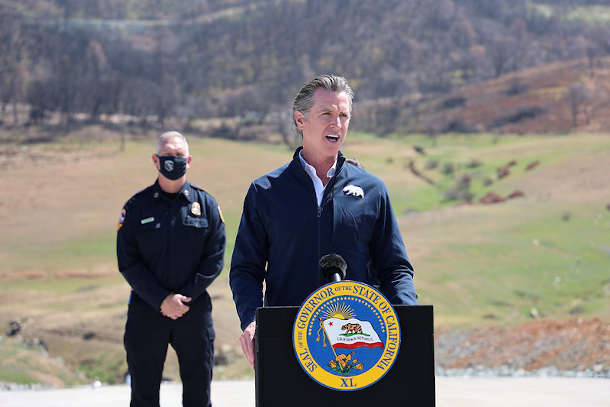
Governor Newsom is proposing $14 billion in funding for climate action and adaptation. (Photo: CALFIRE_official, Flickr CC BY-NC 2.0)
BLUMENFELD: So Steve, if you think about where we are as a planet, I mean, you hear a lot about the existential crisis that climate presents. And, and I think what California has done over a multitude of decades, is really legislate and innovate our way to a place where we can both grow the economy and reduce our greenhouse gas emissions. And that's what the rest of the world is looking at. And one of the sectors we've been incredibly aggressive on -- and we have this dashboard online, that you can see how much renewable energy is feeding the grid in California at any time, and two weeks ago it was that 95% of all the energy comes from renewable sources. So it shows what is possible, right?
CURWOOD: Wait, wait, wait, wait -- 95% of California's energy now coming from renewable resources?
BLUMENFELD: There was a time -- So Steve, this isn't permanent, like in an average year.
CURWOOD: Oh, just for a moment. Yeah, all right.
BLUMENFELD: For a moment, right. But it was a Saturday afternoon and the sun was out. And so we needed not too much energy, and we were getting a lot from solar, and so yeah, it shows the potential. As a state, we're at about 63% is non-fossil fuel. But that still includes today, things like nuclear power and hydro, and we need to move to a place where it's fully renewable 100% of the time. And so when you look at where we get our renewable energy from, it's from two sources: solar, and onshore wind. And the profile, namely, when people need power versus when the sun is shining or the wind is blowing, don't always align. But when you look at offshore wind, which the big announcement was made between the federal government and Gavin Newsom, offshore wind can really fill in that gap. And it's a pretty big deal, like the amount of the ocean that they're dedicating is about 400 square miles. And they estimate that it will be able to produce about four gigawatts, 4000 megawatts of power, which is enough to produce energy for about 3 million homes. So really, really historic day, big deal, big industry for the labor movement, a lot of jobs, a lot of investment. I think it's really the beginning of a turn, which is that businesses can really see that they can make money, consumers can see the real return in things like reliability, and we can achieve our carbon reduction goals.
CURWOOD: So to do this much offshore wind, how dependent is it on the promise that President Biden is making of installing nationwide, some 30 gigawatts of offshore wind?
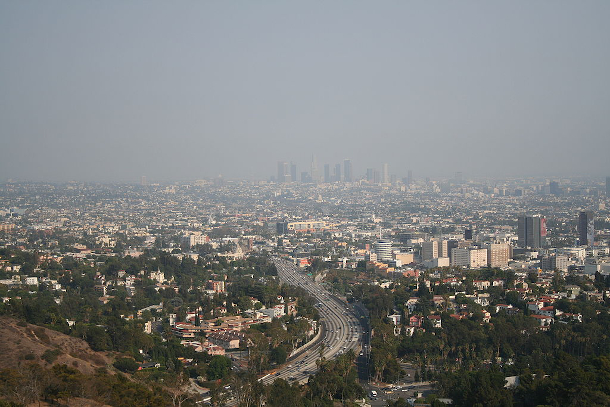
California is home to 7 of the 10 cities in America with the dirtiest air, and black and brown communities are most impacted by air pollution. (Photo: Massimo Catarinella, Wikimedia Commons CC BY-SA 3.0)
BLUMENFELD: I mean, Steve, it is just, you know, often people say, doesn't really matter who the President is. It really matters who the President is! And President Biden has come in, I think, with an incredibly comprehensive jobs and climate package. He's really said, we need to do all of the above and do it quick. So in a matter of months, you know, we were banging our heads against the wall and folks at the California Energy Commission had tried and tried and tried to get the Department of Defense and Interior together, and nothing had happened for four years. I mean, basically Trump did nothing. In four months, the team came on and said, we're gonna make this happen. We're, committed to making it happen. And amazingly, they did. So it takes political leadership to make bold change. We have no choice but to respond to the climate emergency we're in. And it's really, really heartening to have the federal government supporting. I mean, just to give you the contrast, in the Trump administration, we had more than 70 lawsuits just on the environment against the Trump administration. We're now able to roll many of those back. And rather than spend time on legal bills, we're now able to look forward and develop innovative programs. So their help on everything from the clean car standards to how we're thinking about offshore wind has been invaluable.
CURWOOD: Now, President Biden has what he calls a Build Back Better plan in the wake of the economic destruction of the pandemic. Your Governor, Gavin Newsom, is talking about a California Comeback Plan. And there are many elements of this. But Jared, let me ask you, in particular, how does this comeback plan address the matter of environmental justice?
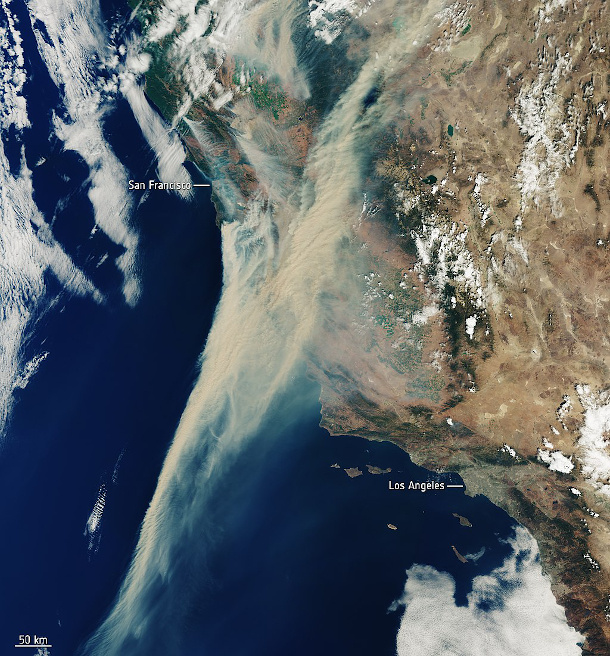
This European Space Agency image from August 19th, 2020 shows smoke from fires ablaze in California. Climate change is exacerbating drought and warmer temperatures in the state, creating dangerous conditions that allow fires to ignite and spread. (Photo: European Space Agency, Wikimedia Commons CC BY-SA 3.0 IGO)
BLUMENFELD: So really, there will be no climate solution, Steve, without making sure environmental justice is also addressed. And you know, environmental justice is environmental racism. Often people don't want to say that. But California has led with this tool, a GIS mapping tool called CalEnviroScreen, if you look up CalEnviroScreen, it looks by census tract. And basically what you see, even in a state like California that prides itself on being progressive, is black and brown communities and low income communities suffer worse environmental pollution than whites in the state, period. And this is completely unacceptable. And I think it's on all of us to make sure that as we're thinking about climate solutions, we're thinking about environmental justice. And in that context, our budget is very focused on making sure that we're funding the things that need and have the greatest impacts in the communities that are overburdened. So an example would be, we're not just saying, we want more electric vehicles that are passenger vehicles, because often those go to wealthy communities like San Francisco or LA. What we're saying is we need to get rid of polluting diesel trucks, that are going from the port of LA and Long Beach to the Inland Empire, we need to get rid of polluting diesel school buses, we need to get rid of polluting tractors and, and vehicles on the farm that hurt rural communities. So in every one of our investments in this $14 billion climate budget, in every single one, we want to make sure that the majority of the funding is going to help communities of color overcome historic burdens. And so this budget really commits to things like $500 million to clean up brownfield communities, another $500 million to deal with a single lead acid battery facility where the company Exide walked away and tried to use bankruptcy to get out of their obligations. So time and time again, I think our budget is focused on, on communities that are on the front lines.
CURWOOD: Look ahead, just 12 months, just one year. What are you hoping, expecting, to have accomplished now, in the comprehensive climate and environmental action plans that we've been talking about here?
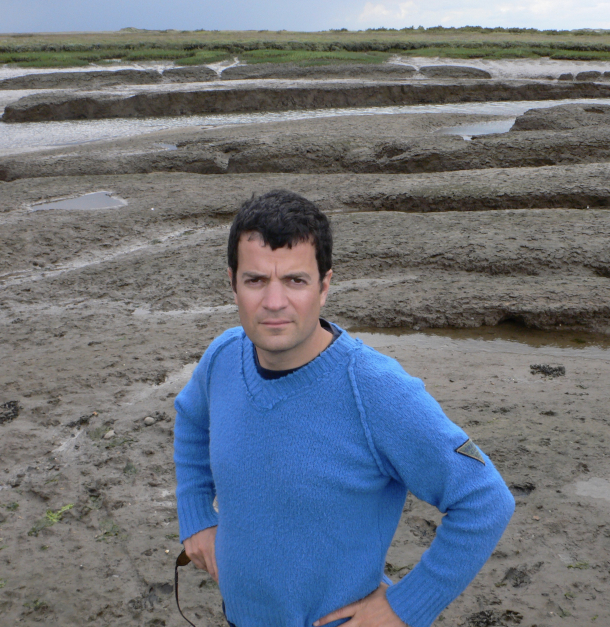
Jared Blumenfeld is California’s Secretary of Environmental Protection and the host of the podcast, Podship Earth. (Photo: Courtesy of Jared Blumenfeld)
BLUMENFELD: This year ahead is really important for us. We are writing the roadmap for 2045 carbon neutrality. What are all the policies that need to be in place? How stringent do they need to be? What are the funding that needs to go behind those? How do we make sure we integrate environmental justice into every element of our planning? How do we think about the just transition of oil field and fossil fuel workers? How do we make sure that each community has the charging infrastructure for electric vehicles? How do we make sure that buildings are designed so that they don't need fossil fuels to run them, all those things are going to be in this scoping plan. That is our blueprint, our roadmap for getting to 2045 carbon neutrality. At the same time, it's really thinking about, what are the big things that we can do now, that will impact the future? And I think the budget that Governor Newsom put forward is a downpayment on that carbon neutral future. It's saying, we have the money now to do some big bold things. We need to do them. And we need to keep pushing forward. Because the science tells us -- and actually you don't need to be a scientist to live in California and know that climate change is real, when you have wildfires that are already starting up as early as May and have a historic drought. So we are looking at how we become resilient. How we make sure that the most vulnerable among us, is the best prepared to deal with the realities of climate change that we probably won't be able to change.
CURWOOD: Jared Blumenfeld is the California Secretary for Environmental Protection and the host of Podship Earth. Thank you so much for taking the time with us, Mr. Host and Mr. Secretary.
BLUMENFELD: Thank you, Steve. Always a pleasure and thank you for doing what you do.
Links
Find Podship Earth here or wherever you get your podcasts
About the California Comeback Plan
NYTimes | “Biden Opens California’s Coast to Wind Farms”
Find CalEnviroScreen and learn more about environmental justice in California
Jared Blumenfeld is the California Secretary for Environmental Protection
Listen to a previous Living on Earth conversation with Jared Blumenfeld
Living on Earth wants to hear from you!
Living on Earth
62 Calef Highway, Suite 212
Lee, NH 03861
Telephone: 617-287-4121
E-mail: comments@loe.org
Newsletter [Click here]
Donate to Living on Earth!
Living on Earth is an independent media program and relies entirely on contributions from listeners and institutions supporting public service. Please donate now to preserve an independent environmental voice.
NewsletterLiving on Earth offers a weekly delivery of the show's rundown to your mailbox. Sign up for our newsletter today!
 Sailors For The Sea: Be the change you want to sea.
Sailors For The Sea: Be the change you want to sea.
 The Grantham Foundation for the Protection of the Environment: Committed to protecting and improving the health of the global environment.
The Grantham Foundation for the Protection of the Environment: Committed to protecting and improving the health of the global environment.
 Contribute to Living on Earth and receive, as our gift to you, an archival print of one of Mark Seth Lender's extraordinary wildlife photographs. Follow the link to see Mark's current collection of photographs.
Contribute to Living on Earth and receive, as our gift to you, an archival print of one of Mark Seth Lender's extraordinary wildlife photographs. Follow the link to see Mark's current collection of photographs.
 Buy a signed copy of Mark Seth Lender's book Smeagull the Seagull & support Living on Earth
Buy a signed copy of Mark Seth Lender's book Smeagull the Seagull & support Living on Earth

